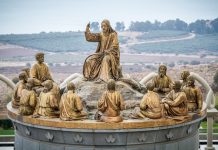
JARED DEES
The goal of lectio divina (“sacred reading”) is to encounter Christ when you read the Bible, not just to understand an idea. We aren’t just reading words from God, we are entering a dialogue with the Word of God himself.
Lectio divina has many forms, but I have found Pope Benedict XVI’s guide in his apostolic exhortation Verbum Domini to be the best. He summarizes the process in four questions, which you will find below. The simplest way to guide students through a process of lectio divina is to read a Scripture passage with them and then ask each of these questions. What follows are some additional creative activities you also might try in class or at home.
1. Reading (lectio): What does the biblical text say in itself?
FOLLOW THE FOOTNOTES: Most Bibles have explanations of terms and phrases in the footnotes at the bottom of each page. Read and summarize these notes with the students to instill in them a practice of actually reading this important information. You can also follow a trail of connections to other passages in the Bible using these notes.
FRONT-LOAD VOCABULARY: Before you read the passage, define difficult words referring to people, places, and concepts the students might not know yet. Explaining the meaning of Greek or Hebrew terms is especially important.
2. Meditation (meditatio): What does the biblical text say to us?
VISUALIZATION: Have the students close their eyes and imagine they were actually present within the Scripture passage you read. They either can act as an outside observer or imagine being one of the people in the passage. Ask them to think about their senses: What would they see, smell, hear, touch, or taste? Ask them to think about how they
would feel if they were there.
TEACH WITH TESTIMONY: What personal stories does reading this passage bring to your mind? Share those stories and invite students to think of similar situations in their lives. If the students aren’t able to make a personal connection in their minds, they won’t be able to have a personal relationship with Jesus in their hearts.
3. Prayer (oratio): What can I say to the Lord in response to his Word?
SPONTANEOUS PRAYER: The simplest way to add prayer to the experience of reading the Bible is to invite students to say or write a spontaneous prayer to God after reading and meditating on the passage. What do they want to say to God? What kind of prayer would be most appropriate: blessing and adoration, petition, intercession, thanksgiving, or praise?
CONVERSATION WITH CHRIST: A common lectio divina practice is to have people imagine they are sitting next to Jesus and having a conversation with him. What would they say to him or ask him about this passage? What would he say in response? (These prayers and conversations can be written on separate sheets of paper or in a journal that students keep throughout the year.)
4. Contemplation (contemplatio): What conversion of the mind, heart, and life is the Lord asking of us?
CONVERSION T-CHARTS: Have students draw a line down the center of a paper. On the left side they will write how they were thinking or acting before reading this passage, and on the right side they will write what they think God is asking them to change.
SILENCE: Resist the urge to overprogram the experience of reading the Bible. Give the students some time to sit in prayerful silence and think about what they’ve read and prayed. Give the Lord a chance to speak to them or instill in them a desire for change
during these moments of silence.
5. The Final Step (actio) Pope Benedict XVI also suggested a final step that follows the
lectio divina process: action (actio). This step “moves the believer to make his or her life a gift for others in charity” (Verbum Domini, 87). Think of this step as ungraded homework. Spend a little time thinking practically with the students about how they can act differently between now and the next time you see them. Follow up and remind them about what they read, asking them how it has impacted their lives in some small way. Follow these steps, and your students will experience the Word of God in a new, personal way. They will see reading the Bible as an opportunity to encounter Christ in prayer, which is unlike the way they read anything else.
Jared Dees is the founder of TheReligionTeacher.com and the author of Christ in the Classroom, which applies the practice of lectio divina to lesson planning.
This article originally appeared in Catechist magazine, September 2018.
PHOTO: A3PFAMILY/SHUTTERSTOCK




